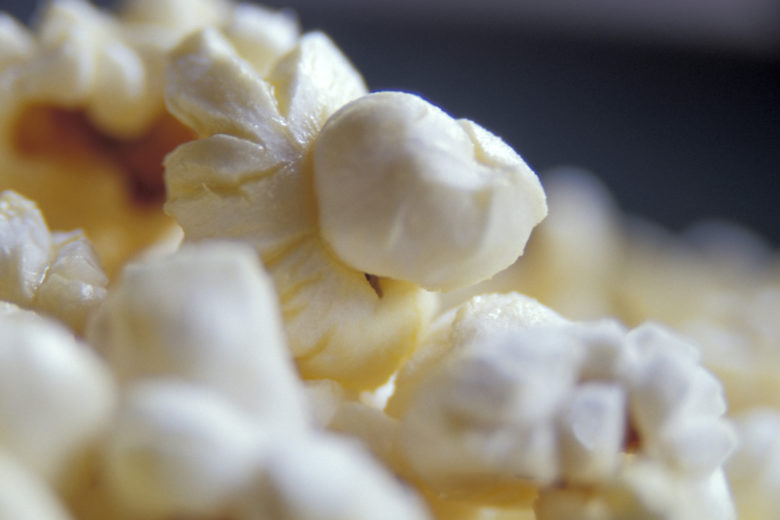
Say goodbye to cupcakes and hello to all-natural, whole-grain popcorn. According to the Popcorn Board, Americans consume about 51 quarts of popcorn per person each year. Beyond movie theaters, popcorn is replacing nuts as a pub snack and can be found as an ingredient in savory and sweet foods including soups and desserts. Gourmet flavor options range from traditional caramel to wasabi, bacon, kale and Sriracha.
Depending on preparation and portion size, popcorn can be a healthful and delicious snack — or a vehicle for added sugar, fat, calories and sodium.
Popping Good
Many people don’t realize popcorn is 100-percent whole-grain, low in calories and a source of dietary fiber. A three-cup serving of air-popped popcorn has fewer than 100 calories, 1 gram of fat, 3.5 grams of dietary fiber and 2 milligrams of sodium. “Our customers are passionate about finding healthy snacks for their families, and popcorn is our leading whole-grain snack that fits the bill,” says Jane Andrews, MS, RD, nutrition and labeling manager at Wegmans Food Markets, Inc.
A National Health and Nutrition Examination Survey has shown that popcorn accounts for 12 percent of whole-grain food sources in children’s diets and 9 percent in adults. Popcorn is a healthy snack, but the American Academy of Pediatrics does not recommend children under 4 consume it due to choking risk.
Portion Control
Crunchy, salty and guilt-free is how some people view popcorn, but that’s not always the case. Popcorn can be an addictive treat that contains as many calories as a meal instead of a snack. Eating popcorn out of big tubs at movie theaters is common, but a large bucket can contain more than 1,000 calories and several days’ worth of saturated fat.
A 2005 study showed moviegoers ate 45 percent more fresh popcorn and 34 percent more 14-day-old popcorn when it was served in large containers. Center for Science in the Public Interest nutrition policy director Margo Wootan, DSc, says blame it on biology. “We are hardwired to eat food when it is placed in front of us, and it is difficult to stop, especially when distracted by the movie,” says Wootan.
Since air-popped popcorn is not available at theaters, choose a small portion without added buttery toppings. Most small sizes contain six cups, so share it with a friend.
Theater Popcorn
In 1994, sales at movie theaters reportedly plummeted after CSPI’s headline-grabbing campaign nominated movie theater popcorn for “Best Supporting Actor in the Obesity Epidemic.”
As popcorn came under the spotlight, so did the saturated fat from coconut oil used by most movie theaters to pop it. CSPI reported that a medium-sized serving of buttered popcorn contained 37 grams of saturated fat, almost double the recommendation of 20 grams per day.
In 2009, CSPI did a follow-up and found many theater chains continued using coconut oil, while others had switched to oils lower in saturated fat, such as canola. “We were stunned by the calories and fat from the giant serving sizes, and saturated fat from popping oil,” Wootan says. “[Those] are the real culprits.”
Many chains use a “buttery,” non-hydrogenated soybean oil topping that adds about 120 to 130 calories per tablespoon. Even without the topping, movie theater popcorn can be heavily seasoned with salt, ranging from 210 milligrams to 1,500 milligrams. By December 2015, new labeling regulations that require posting nutrition information will be implemented and may help take the guesswork out of calculating calories in movie theater popcorn.
Popping at Home
Even at home, movies go hand-in-hand with popcorn. Not much is easier than microwave popcorn, but some varieties still contain trans fats. Air-popped popcorn delivers the goods with none of the fat and only 31 calories per cup. When oil-popped, it contains about 55 calories, depending on how much oil is used. Even drizzled lightly with butter, it’s 90 to 120 calories per cup. When choosing microwave popcorn, Wootan suggests 100-calorie, single-serving bags that are 94-percent fat-free and contain less than 0.5 grams of saturated fat and no partially hydrogenated oil.
Most bagged pre-popped popcorn does not contain trans fats, but it can be high in calories. Candy-coated popcorn can have up to 10 teaspoons of added sugar, making it more like a decadent dessert than a whole-grain snack. You also can pop your own popcorn at home and portion it into single-serving bags or containers. One serving of popped popcorn is three cups.
Pop Your Own
Make your own popcorn, and go light on the salt. Put ¼ cup of kernels in a brown paper lunch bag, and add a teaspoon of vegetable oil. Fold the top twice, place bag in the microwave and pop for 2 to 3 minutes. Or, use the same ingredients in a pot on the stove over medium-high heat. Keep the lid on — popcorn kernels can pop up to three feet in the air! Shake continuously until popping ceases.
Nutrition Analysis of Popcorn
Air-Popped Popcorn
Serving size: 3 cups popped
Calories: 93; Total fat: 1g; Saturated fat: 0g; Cholesterol: 0mg; Sodium: 2mg; Carbohydrate: 19g; Fiber: 3.5g; Sugars: 0g; Protein: 3g; Potassium: 79mg; Phosphorus: 86mg
Oil-Popped Popcorn, Salted
Serving size: 3 cups popped
Calories: 154; Total fat: 7g; Saturated fat: 1g; Cholesterol: 0mg; Sodium: 292mg; Carbohydrate: 19g; Fiber: 3.5g; Sugars: 0g; Protein: 3g; Potassium: 72mg; Phosphorus: 72mg
Think Outside the Bag
Try these simple ideas to jazz up your popcorn:
- Sprinkle popcorn with chili powder and a squirt of lime juice
- Mix it with roasted chickpeas or nuts
- Toss it with Parmesan cheese and fresh rosemary
- Add some heat with cayenne pepper or Cajun seasoning mix
- Drizzle with olive oil and sprinkle with garlic and black pepper
- Dust with cinnamon and a little brown sugar
